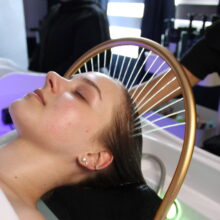5 Ways to Guarantee You Get a Great Massage
- Published: Thursday, January 22nd 2015
- in Living Well
 Stress is a fact of life and it can make us nuts. To keep from pulling out their hair (or someone else’s) more people than ever before are turning to massage therapy for stress reduction. Proof in the numbers: the American Massage Therapy Association estimates the U.S. massage industry at $10 billion. That figure is driven by the roughly 35-million adults (16 percent) who have had a massage at least once.
Stress is a fact of life and it can make us nuts. To keep from pulling out their hair (or someone else’s) more people than ever before are turning to massage therapy for stress reduction. Proof in the numbers: the American Massage Therapy Association estimates the U.S. massage industry at $10 billion. That figure is driven by the roughly 35-million adults (16 percent) who have had a massage at least once.
No longer viewed solely for pampering, massage offers a non-invasive, drug-free approach to wellbeing and allows the body to heal itself. Some of the benefits received from regular massage are:
- Increased circulation, which allows more oxygen and nutrients to reach your vital organs.
- Stimulation of your body’s natural defense system, which helps increase cells that fight off inflammation.
- Tension release in sore or tired muscles.
- Endorphins are released, which are your body’s natural anti-depressant.
As the Natural Health Explorer for the television show Journey into Wellbeing and co-owner of Well World Group, a spa education and consulting company, I have spent a great deal of time with massage therapists as well as with their clients. Through our interactions, some themes have emerged that seem to be the reasons for dissatisfaction with the service. It’s important to address these concerns; after all, if you plan on paying between $60-120 for a massage, you should enjoy it.
Whether you are a newbie or have been experiencing the healing benefits of massage for some time, there are some surefire ways a massage can end up creating – instead of relieving – stress. It is up to you, as the client, to ensure you have done your part to receive the incredible benefits a great massage offers.
Think back to your very first massage. What was going through your mind? Regardless of how vocal you are typically, once you find yourself lying nude and face down on a massage table, you may find it challenging to communicate your needs. There is a power differential that exists and it is up to you to communicate to the therapist so they are aware of your needs throughout the massage. Eric Stephenson, Director of Education for imassage, Inc. says, “Massage is a dance. This popular analogy is often used to illustrate the dynamic, spontaneous nature of communication between client and therapist. For it to be a fluid, successful exchange, both parties must give and receive feedback”.
The following concerns come from hundreds of conversations with clients over the years and are especially beneficial to remember:
1. Research from the International Spa Association shows nudity to be the number one fear of massage clients. Therapists receive training on how to properly drape their clients, but all will have different styles and, sometimes, draping can become careless. If, at any time during the massage, you feel exposed or uncomfortable, simply ask the therapist to adjust the drape or adjust it yourself. This also protects the therapist, as it only takes one complaint due to inattentiveness to lead to the loss of their license.
2. Too much or not enough pressure. Within the first portion of your massage, the therapist should always check in with you on pressure. This is your opportunity to guide the rest of the massage. Instead of answering “Uh-huh”, clearly state your needs: “Actually you can apply more pressure” or “I’m okay if you lighten up just a bit”. If your needs change during the massage or their pressure changes, just ask for them to adjust accordingly. Most are very willing to accommodate this request and want you to enjoy the service. If your therapist does not check in with you on pressure, clearly ask if they can change their technique if what they are doing does not work for you.
3. I didn’t get what I wanted. One of the top complaints expressed by clients is that they didn’t get what they wanted from the massage. During the intake portion, you have the opportunity to express your desires. Don’t miss out on this by saying everything is fine. Be specific with what you want. For example, “I would like an extra 15 minutes of work on my feet and shins to help alleviate pain from running.” Or “I prefer medium pressure and would like to add in a scalp massage.” If you make a request at the beginning of the session and the therapist has not worked the area you requested, halfway through the session, you can remind them about the problem area. Client requests made during the intake process are part of getting an agreement for how the session will unfold. The therapist’s job is to listen to your needs and deliver upon them.
4. Lack of presence. At times, we all get busy and distracted while at work. But, when a massage therapist is checked out, this can really lessen the value of a treatment. Most clients look forward to their massage, and there is nothing worse than having a therapist who is thinking about what they will have for dinner while they work with you… or even worse, mindlessly chatting through the entire session. Massage may be the only time during that month (or year, but I hope it’s not that long!) that you get to just relax. Also, on that note, communicate early-on if you would prefer a quiet session.
5. I need recommendations. A professional recommendation is a crucial part of the massage experience and one that is often missed. If your therapist does not offer insight into your condition or recommend a time to return, ask during the end of the session what they noticed and what they would recommend.
Next time, ensure you have a great massage session by confidently asking for the type of massage you wish and not hesitating to communicate during the session.
You may also like:



